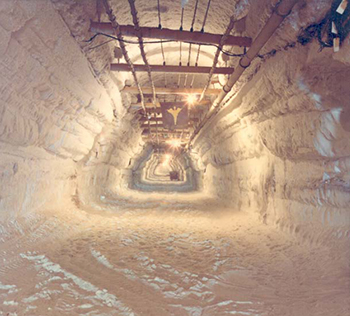Source: Geophysical Research Letters
In 1959, during the height of the Cold War, the U.S. Army Corps of Engineers built Camp Century, a military base in northwestern Greenland encased completely within the Greenland Ice Sheet. The camp’s official purpose was to test construction techniques in the Arctic and conduct scientific research, but it doubled as a top secret site for testing the feasibility of deploying nuclear missiles that could reach the Soviet Union in case of nuclear war.
Greenland is a Danish territory, and although the United States had Denmark’s approval to build Camp Century, the missile launch program, known as Project Iceworm, was kept secret from the Danish government. Several years after the camp became operational, however, Project Iceworm was rejected by the Joint Chiefs of Staff, and the camp was decommissioned in 1967. The Army Corps of Engineers removed the nuclear reactor that powered the camp but left the camp’s infrastructure and waste behind, under the assumption they would be frozen and buried forever by perpetual snowfall.
But in the decades since Camp Century was abandoned, climate change has warmed the Arctic more than any other region on Earth. Here Colgan et al. take an inventory of the wastes at Camp Century and run climate model simulations to determine whether the waste will stay put in a warming Arctic. The team analyzed historical Army Corps of Engineers documents to determine where the wastes are located, how deep under the ice sheet they are buried, and how much the ice sheet has moved since the 1950s.
The team estimates the site contains 200,000 liters of diesel fuel, enough for a car to circle the globe 80 times. Considering the building materials used in the Arctic at the time, the authors speculate that the site also contains polychlorinated biphenyls (PCBs), which are pollutants toxic to human health. They also estimate the site has 240,000 liters of wastewater, including sewage, along with an unknown volume of low-level radioactive coolant from the nuclear generator.

Looking at existing business-as-usual climate projections, the team determined that as early as 2090, the portion of the ice sheet covering Camp Century could transition from net snowfall to net melt. Melting of the ice would guarantee that the camp’s infrastructure and waste, which represents a significant environmental hazard, would remobilize, according to the authors.
If that happens, pollutants could be transported to the ocean, where they could disrupt marine ecosystems. The authors do not advocate for starting remediation activities at Camp Century now, however. The waste is buried tens of meters below the ice, and any cleanup activities would be costly and technically challenging, according to the researchers, but the new study does raise questions about who is responsible for cleaning up the waste when it is exposed.
Although Camp Century was a U.S. base, it is on Danish soil, and while Greenland is a Danish territory, it is now self-governing. According to the authors, the implications of climate change on such politically ambiguous abandoned wastes have never been considered before. (Geophysical Research Letters, doi:10.1002/2016GL069688, 2016)
—Lauren Lipuma, Contributing Writer
Citation:
Lipuma, L. (2016), Melting ice could reveal toxic Cold War era waste in Greenland, Eos, 97, https://doi.org/10.1029/2016EO058149. Published on 07 September 2016.
Text © 2016. The authors. CC BY-NC-ND 3.0
Except where otherwise noted, images are subject to copyright. Any reuse without express permission from the copyright owner is prohibited.

